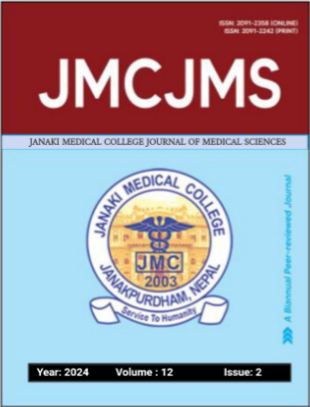Epidemiological Pattern and Case Fatality Rate among COVID-19 Patients during First and Second Wave of Pandemic in Madhesh Province, Nepal
DOI:
https://doi.org/10.3126/jmcjms.v12i02.69156Keywords:
COVID-19, case fatality rate, Madhesh ProvinceAbstract
Background & Objectives: Evaluating multi-wave patterns of COVID-19 infection, hospitalization, and mortality across spatial scales can inform public health strategies for future pandemics. However, there is limited understanding of these patterns in developing countries, including Nepal. This study aimed to analyze epidemiological patterns, fatality rates, and factors associated with severe outcomes during the first and second waves of COVID-19 in Madhesh Province, Nepal.
Materials and Methods: This retrospective cross-sectional study used provincial health records from Madhesh Province, covering April 9, 2020, to December 15, 2021, to analyze 37,551 positive COVID-19 cases and 1,037 deaths across two waves. The study examined changes in COVID-19-related deaths, with data on demographics, residence, isolation sites, treatment hospitals, care levels, and testing laboratories. The frequency and percentage of the variables were presented. The case fatality rate (CFR) for different categories were calculated. Additionally, the case fatality rate ratio (CFRR) for the first wave against second wave was obtained. Finally, case fatality risk ratios with 95% confidence intervals were presented. A p-value of <0.05 was set as statistically significant.
Results: The case fatality rate (CFR) for COVID-19 was significantly higher in the second wave, especially among the elderly (≥47 years), and in institutional isolation (7.82%). Tertiary level care and private hospitals consistently showed higher CFRs. Furthermore, the multivariable analysis of risk ratios (RR) for COVID-19 case fatality in revealed that the 25–34 year age group had the highest RR (2.39). Similarly, males had a higher RR (1.42) than females, and institutional isolation had a substantially higher RR (93.33) compared to home isolation. Primary level care RR (28.11) and government hospitals RR (4.32) showed a higher risk. Place of residence also impacted the RR, with Sarlahi (7.68) having higher.
Conclusion: A significant increase in COVID-19 case fatality rates during the second wave, particularly among the elderly and those in institutional isolation. Higher mortality was observed in tertiary hospitals and among those who were tested in private laboratories, with substantial variations in risk ratios based on age, isolation type, and place of residence.
Downloads
Downloads
Published
How to Cite
Issue
Section
License
© JMCJMS, JMC, Janakpur, Nepal




